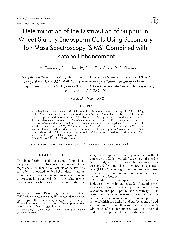摘要
Secondary ion mass spectrometry (SIMS) is a sensitive, high resolution technique capable of determining the location of elements or ions in a sample down to sub-cellular levels. The distribution of elements or ions are superimposed onto an image of the plant cell or tissue generated by ion-induced secondary electrons, allowing a visual representation of their positions in the sample. The elements are separated by their mass/charge ratios which can lead to a loss of sensitivity when separating signals from elements with very similar masses such as O-16(2) (31-990 a.m.u.) and S-32 (31-972 a.m.u.). The abundance of S-34 isotope was, therefore enriched, allowing sulphur to be located at the starch granule/protein interface of the mature wheat gain. This demonstrates that isotopic enrichment can be used to extend the applications of SIMS technology to biological systems.
- 出版日期2003-5
